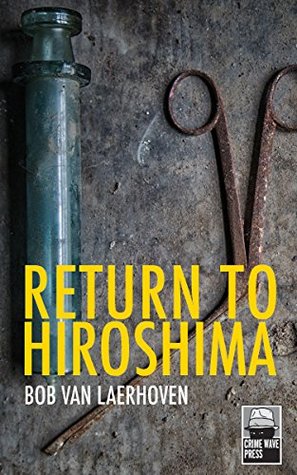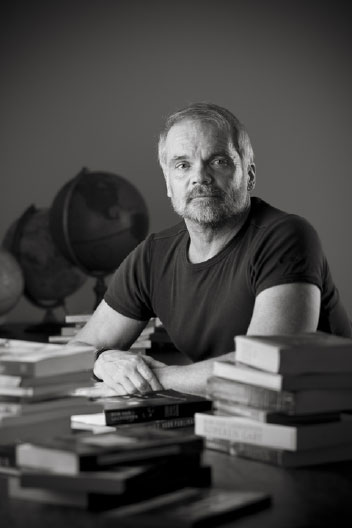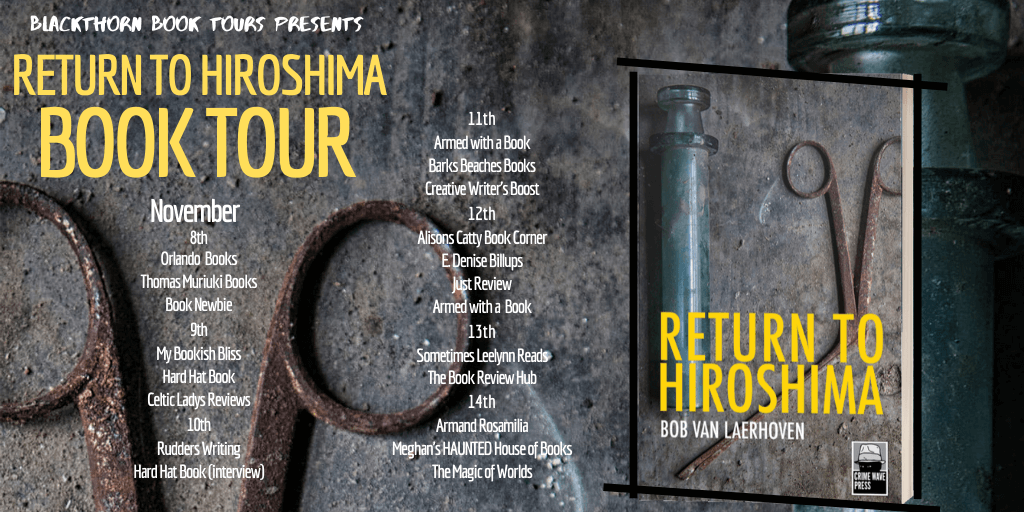

Connecting with authors and asking them about their book, inspiration and writing always helps me understand the book better. Bob Van Laerhoven is a 66-year-old Belgian/Flemish author who has published (traditionally) more than 45 books in Holland and Belgium. His cross-over oeuvre between literary and noir/suspense is published in over 10 languages, with a Chinese production currently in the works. For a book as interesting and detailed as Return to Hiroshima, it was a pleasure to talk to Bob about his relationship to Japan, the risks he took to write this novel, the help he had from academics and other professionals.
Many thanks to Blackthorn Book tours for this opportunity! You can check out my thoughts on the book here. Right now though, sit back, enjoy the interview, and get some insights about the book! 🙂
- Do you have roots in Japan? Why did you choose Hiroshima and Hashima Island as the primary setting for this novel?
I don’t have roots in Japan at all, but, for more than thirty years, I’ve been an avid student of budo, the Japanese martial arts, and their descendants the fighting sports. When I learned about the bushido code, the Way of the Warrior, I began reading a lot about Japan’s culture and history. Two of them were about the consequences of the nuclear bomb “Little Boy” dropped on Hiroshima. Slowly, over the years, I began dreaming about writing a novel set in Japan, but I shied away from the project, thinking it was far too difficult for me, the humble Flemish author that I am.
Then, by chance, coincidence – or was it Fate? – I saw a documentary about deserted Hashima Island, also called “Gunkanjima” – Battleship Island – due to its unique silhouette, lying before the coast of Nagasaki. Battleship Island made me think about WWII and of course, the first atom bomb ever used in war conditions in humanity’s history in Hiroshima. Slowly, a story was shaping itself in my mind, and it must have pleased my Muse because she threw unexpected a book at my feet: Unit 731 Testimony, subtitled: Japan’s Wartime Human Experimentation Program. In his book, author Hal Gold delivers a portrait of the Imperial Japanese Army’s most feared medical unit in WWII and describes its shocking activities and experiments on prisoners of war. And there it was: I felt the irresistible urge to start writing descending upon me and wrote the first sentence of Return to Hiroshima. A year and a half later, I finished the first draft of the novel, 400 pages long.
- I learned many new things through your work. What kind of research did you do about WWII Japan and the society in the early 1990s?
I knew from the start that the novel had to take place in the early 1990s because I ‘invented’ the rogue prince Norikazu who had done terrible deeds during WWII when he was still a teenager. When the novel starts, Norikazu is in his sixties, but more dangerous than ever, gone underground as a charismatic yakuza-boss, the powerful Japanese mafia. The plot came easily to me, but it was the details of every-day-living in Japan that gave me lots of trouble… until I could ask a Belgian police-officer who had spent a lot of time in Japan as a liaison-officer about all the intricate details of the Japanese culture: how to eat, what to eat, how to behave, what is hip, what is not, what is a taboo, and so on. From that point on, it was smooth sailing. Ehhh, as far as smooth sailing goes in writing multi-layered novels like this one.
- Apart from the Hiroshima and Nagasaki atom bomb, and the Japanese experiments during the war, were there other truths that inspired the novel?
In 1995, Japan struggled with a severe economic crisis, and this background plays a discrete but important role in the novel. Shocked by the sharp decline of the powerful Japanese economy, also the classical values of Japanese society began to suffer. Young people reacted against the rigid ‘beehive-mentality’ of Japanese culture, and violence was rising, albeit in the hidden catacombs of society. Many irritations, anger and loss of the famous Japanese “self-control” boiled underneath the ‘clean reputation’ of Japanese society. The Yakuza-gangs became even more powerful and the economic crisis unearthed a lot of secrets hiding behind the polite and inscrutable facade of the community. The chasm between traditional culture and urban ways, between old and young, grew frighteningly quickly. And that precisely was what I needed for this novel.
- Several characters in Return to Hiroshima struggle with the idea that they do not belong to the mainstream Japanese society, and yet they continue to live there. Why is that?
We must not forget that Japan is an island. Island dwellers all over the world have a somewhat special mentality. Emigrating from an island is a lot more difficult than elsewhere, where you only have to cross borders to leave your country. Secondly, Japanese society is rigid: obeying hierarchy is engraved in the Japanese psyche. In spite of all these factors, the modern evolution of values and duties creates a lot of alienation and distress, especially between the older generation and the youth. Young people long for a more permissive society or to go living elsewhere, but there is a large gap between their dreams and reality. Leaving Japan, leaving the maze of family and like-minded people is frightening to them, in spite of their dreams.
- You have written a number of novels. How is this one different from your other works?
I am a fulltime writer in a small language community – Flanders has five million people – since around 1990 and I published (traditionally) more than 40 books: literature, suspense, cross-over between literature and suspense, coming-of-age novels, semi-autobiographical novels, a novel in letters, a compilation of diary entries, and so on.
Return to Hiroshima belongs to the class of cross-over novels between mainstream literature, historical fiction, and noir. It is the bleakest and harshest novel I’ve ever published, and I’ve paid an emotional toll writing it.
Return to Hiroshima is a multi-layered book wherein many themes have their role, but, ultimately, the most important theme of the novel is the ferocious and terrible destruction of a whole city by the first nuclear bomb ever used in war-conditions. On that day, August 6th 1945, humanity opened the door that can lead to total self-destruction of humankind and the planet.
- I truly enjoyed your style of writing. What are some works or writing exercises that helped you develop such a writing style?
Writing exercises haven’t helped me developing my style because I never did them. Passion for poetry has chiseled my writing. When I was young, I longed to become a poet, but it became soon clear that I didn’t possess sufficient poetic talent. I learned that I was a novelist, a storyteller, at heart, so I tried to be as poetic as I could in my stories.
My fascination for poets stayed with me all my life. Baudelaire’s Revenge, one of my best literary suspense novels, is, in fact, a homage to the famous French “doomed poet” Charles Baudelaire with his masterpiece The Flowers Of Evil. I understand that reading about the intricacies of style or practicing writing exercises can help an author, but, ultimately, it’s the depth of your desire to be a stylist that helps you in your quest to bring forth your true “inner voice.”
- What would you recommend your readers to read after Return to Hiroshima?
If you were Dutch or Flemish, I could recommend a lot of my other titles in the cross-over genre and also in mainstream literature, but since you’re asking about titles that were translated into English, I must limit myself to one novel and two short stories collections.
I mentioned Baudelaire’s Revenge earlier. The novel is set in 19th century Paris and is an atmospheric mystery. Baudelaire’s Revenge won me the USA Best Book Award 2014 in the category “mystery/suspense” and is also translated into French and Russian.
My first short story collection, Dangerous Obsessions was voted “best short story collection of 2015” by the San Diego Book Review. Heart Fever” my second collection, was one of the five finalists of the American Silver Falchion Award 2018 in the category “short stories collections.” I was the only non-American finalist in the competition. My short stories are also translated into French, Italian, Spanish, Swedish, Polish and Portuguese.
- How do you select the names of your characters? Are they just names that appeal to you, did you look them up for a special meaning?
Ah, the names! They were a pain in the ehhh… I had to make sure that I wasn’t giving female names to male characters and vice versa. I contacted a Flemish Japanese language professor who helped me a lot. For the character prince Norikazu, I needed a symbolic nickname. After a long search, I found that the classical Japanese demon Rokurobi is almost always female, but rarely, does the male demon Rokurobei, The Lord of Lies, makes his appearance in the legends. Bingo! The Lord of Lies sprang into life.
- What would you tell your younger self when it comes to writing?
I started writing at a very young age, and I was terribly ambitious. Looking back, I regret that I wasted much time thinking about which stories would be “commercial.” It took me a lot of mistakes before I realized that I had to write about what was important and necessary to me instead of searching how to please readers. Only then I was able to write the novels I was destined to write.
From that moment on my work received depth and passion. Oh, I know, I could have written much easier stuff, truly commercial and bestselling novels if I had wanted to. Instead, I’m proud to be a “difficult, different and dangerous” writer, as one of my reviewers called me.
I hope you enjoyed the interview! Be sure to check out other people’s stops as part of the blog tour and pick up Return to Hiroshima at your earlier convenience. My thoughts on it here.
** Return to Hiroshima is now out in stores so get a copy and let me know what you think! **
Amazon Print
Amazon Kindle

You can connect to Bob through the following channels:
Cover image: Photo by Jase Bloor on Unsplash

Be First to Comment